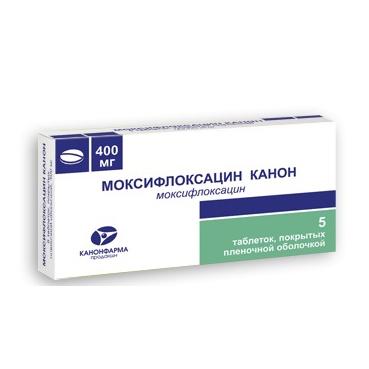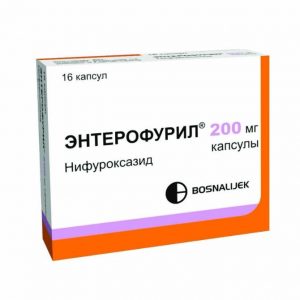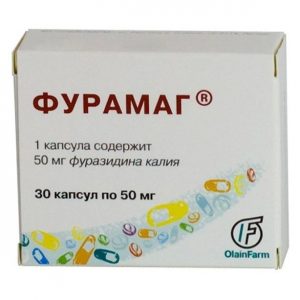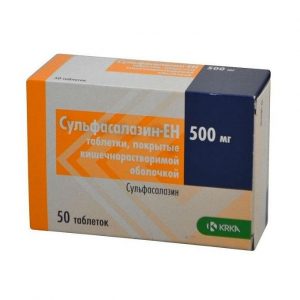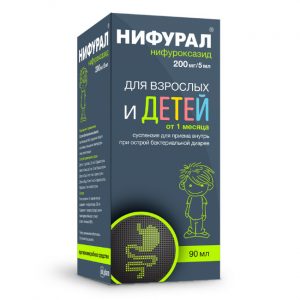Description
Latin name
Moxifloxacine Canon
Release form
Yellow film-coated tablets, oval, biconvex in cross section – light yellow.
Packing
5 pcs – blister packs (aluminum / PVC) (1) – packs of cardboard.
Pharmacological action
Antimicrobial agent from the group of fluoroquinolones, it is bactericidal. It is active against a wide range of gram-positive and gram-negative microorganisms, anaerobic, acid-resistant and atypical bacteria: Mycoplasma spp., Chlamydia spp., Legionella spp. Effective against bacterial strains resistant to beta-lactams and macrolides. It is active against most strains of microorganisms: gram-positive – Staphylococcus aureus (including strains insensitive to methicillin), Streptococcus pneumoniae (including strains resistant to penicillin and macrolides), Streptococcus pyogenes (group A) gram-negative – Haemophilus influenzae, including non-beta-lactamase producing strains), Haemophilus parainfluenzae, Klebsiella pneumoniae, Moraxella catarrhalis (including both non-beta-producing and non-beta-producing strains), Escherichia coli, Atypical Enterobacter cloacae – Chlamydia pneumoniae, Mycoplasma pneumoniae. According to in vitro studies, although the microorganisms listed below are sensitive to moxifloxacin, however, its safety and effectiveness in treating infections has not been established. Gram-positive microorganisms: Streptococcus milleri, Streptococcus mitior, Streptococcus agalactiae, Streptococcus dysgalactiae, Staphylococcus cohnii, Staphylococcus epidermidis (including strains that are sensitive to methicillin, Stemylococcus haemolyticophis, Staphylococcus staphylocius, Staphylococcus staphylocius, Staphylococcus staphylocifactius, Staphylococcus staphylocius, Staphylococcus vulgaris, Staphylococcus haemolyticophis, Staphylococcus vulgaris, Staphylococcus haemolyticophis, Staphylococcus staphylochemis, Staphylococcus staphylochemis, Staphylococcus staphylochemis, Staphylococcus staphylochemis, Staphylococcus staphylochemis, Staphylococcus staphylochemis Gram-negative organisms: Bordetella pertussis, Klebsiella oxytoca, Enterobacter aerogenes, Enterobacter agglomerans, Enterobacter Intermedius, Enterobacter sakazaki, Proteus mirabilis, Proteus vulgaris, Morganella morganii, Providencia rettgeri, Providencia stuartii. Anaerobic microorganisms: Bacteroides distasonis, Bacteroides eggerthii, Bacteroides fragilis, Bacteroides ovatus, Bacteroides thetaiotaornicron, Bacteroides uniformis, Fusobacterium spp., Porphyromonas spp., Porphyromidomasonomiusfromomonas anaerobius, Porphorphromonas anaerobius, as well as Porphorphyromonas anaerobius, Porphorphyromonas anaerobius, Porphorphromonas anaerobius ramosum. Atypical microorganisms: Legionella pneumophila, Caxiella burnettii.
Blocks topoisomerases II and IV, enzymes that control the topological properties of DNA and are involved in DNA replication, repair, and transcription. The effect of moxifloxacin depends on its concentration in the blood and tissues. Minimum bactericidal concentrations almost do not differ from minimum inhibitory concentrations.
Resistance mechanisms that inactivate penicillins, cephalosporins, aminoglycosides, macrolides, and tetracyclines do not affect the antibacterial activity of moxifloxacin. There is no cross-resistance between moxifloxacin and these drugs. A plasmid-mediated resistance development mechanism was not observed. The overall incidence of resistance is low. In vitro studies have shown that resistance to moxifloxacin develops slowly as a result of a series of consecutive mutations. With repeated exposure to microorganisms with moxifloxacin in subminimal inhibitory concentrations, the BMD indicators only slightly increase. Cross-resistance is observed between drugs from the fluoroquinolone group. However, some gram-positive and anaerobic microorganisms resistant to other fluoroquinolones, sensitive to moxifloxacin.
Pharmacokinetics
After oral administration, moxifloxacin is absorbed rapidly and almost completely. After a single dose of moxifloxacin at a dose of 400 mg Cmax in the blood is reached within 0.5-4 hours and is 3.1 mg / L.
After a single infusion at a dose of 400 mg for 1 h, Cmax is reached at the end of the infusion and amounts to 4.1 mg / l, which corresponds to an increase of approximately 26% compared with the value of this indicator when taken orally. With multiple IV infusions at a dose of 400 mg for 1 hour, Cmax varies in the range from 4.1 mg / L to 5.9 mg / L. Average Css of 4.4 mg / L is reached at the end of the infusion.
Absolute bioavailability is about 91%.
Pharmacokinetics of moxifloxacin when taken in single doses from 50 mg to 1200 mg, as well as a dose of 600 mg / day for 10 days is linear.
The equilibrium state is reached within 3 days.
Binding to blood proteins (mainly albumin) is about 45%.
Moxifloxacin is rapidly distributed in organs and tissues. Vd is approximately 2 L / kg.
High concentrations of moxifloxacin in excess of those in plasma are created in the lung tissue (including alveolar macrophages), in the mucous membrane of the bronchi, in the sinuses, in soft tissues, skin and subcutaneous structures, foci of inflammation. In interstitial fluid and in saliva, the drug is determined in a free, non-protein bound form, at a concentration higher than in plasma. In addition, high concentrations of the active substance are determined in the organs of the abdominal cavity and peritoneal fluid, as well as in the tissues of the female genital organs.
Biotransforms to inactive sulfo compounds and glucuronides. Moxifloxacin is not biotransformed by microsomal liver enzymes of the cytochrome P450 system.
After passing the 2nd phase of biotransformation, moxifloxacin is excreted from the body by the kidneys and through the intestines both unchanged and in the form of inactive sulfo compounds and glucuronides.
It is excreted in the urine, as well as in the feces, both unchanged and in the form of inactive metabolites. With a single dose of 400 mg, about 19% is excreted unchanged in the urine, about 25% – with feces. T1 / 2 is approximately 12 hours. The average total clearance after administration at a dose of 400 mg is from 179 ml / min to 246 ml / min.
Indications
Upper and lower respiratory tract infections: acute sinusitis, exacerbation of chronic bronchitis, community-acquired pneumonia of skin and soft tissue infections.
Contraindications
Children and adolescents under 18 years of age, pregnancy, lactation (period of breastfeeding), hypersensitivity to moxifloxacin.
Use in cases of impaired liver function
Moxifloxacin is prescribed with caution in liver failure.
Use in elderly patients
During therapy with fluoroquinolones, elderly patients may develop inflammation and tendon rupture. At the first signs of pain or inflammation of the tendons, patients should stop treatment and release the affected limb from the load.
Use during pregnancy and lactation
Moxifloxacin is contraindicated in pregnancy and lactation (breastfeeding).
Composition
1 tab.
moxifloxacin hydrochloride 436.35 mg,
, which corresponds to the content of moxifloxacin 400 mg
Excipients: calcium stearate 7 mg, corn starch 50 mg, croscarmellose sodium 21 mg, mannitol 55 mg, povidone 25 mg, cellulose 106 microc.
Composition of the film coat: Opadry II yellow 21 mg, including: polyvinyl alcohol 8.4 mg, macrogol (polyethylene glycol) 4.2 mg, talc 3.15 mg, titanium dioxide 3.5 mg, yellow iron oxide 1.75 mg.
Dosage and administration
Inside, 400 mg 1 time / day. The course of treatment for exacerbation of chronic bronchitis – 5 days, community-acquired pneumonia – 10 days, acute sinusitis, infections of the skin and soft tissues – 7 days.
Side effects of the
Digestive system: abdominal pain, nausea, diarrhea, vomiting, dyspepsia, flatulence, constipation, increased activity of hepatic transaminases, taste perversion.
From the side of the central nervous system and peripheral nervous system: dizziness, insomnia, nervousness, anxiety, asthenia, headache, tremor, paresthesia, leg pain, cramps, confusion, depression.
From the cardiovascular system: tachycardia, peripheral edema, increased blood pressure, palpitations, chest pain.
From the laboratory side: a decrease in prothrombin level, an increase in amylase activity.
From the hemopoietic system: leukopenia, eosinophilia, thrombocytosis, thrombocytopenia, anemia.
From the musculoskeletal system: back pain, arthralgia, myalgia.
From the reproductive system: vaginal candidiasis, vaginitis.
Allergic reactions: rash, itching, urticaria.
Drug Interaction
With the simultaneous use of antacids, minerals, multivitamins impair absorption (due to the formation of chelate complexes with polyvalent cations) and reduce the concentration of moxifloxacin in plasma (concurrent).
Phototoxic reactions may occur when receiving moxifloxacin against other fluoroquinolones.
Ranitidine reduces moxifloxacin absorption.
overdose There is limited data on an overdose of moxifloxacin. In case of overdose, it is necessary to focus on the clinical picture and carry out symptomatic supportive therapy with ECG monitoring. Activation of activated carbon at an early stage of absorption prevents further systemic exposure of moxifloxacin, which should be considered in case of overdose of the drug.
Storage conditions
Store in a dry, dark place at a temperature not exceeding 25 ° C.
Keep out of the reach of children.
Expiration
2 years. Do not use after the expiry date.
Deystvuyuschee substances
Moxifloxacin
Pharmacy terms of delivery
Prescription
Possible product names
moxifloxacin canon tablets coated film 400 mg 5 pcs.
Kanonfarma, Russia
